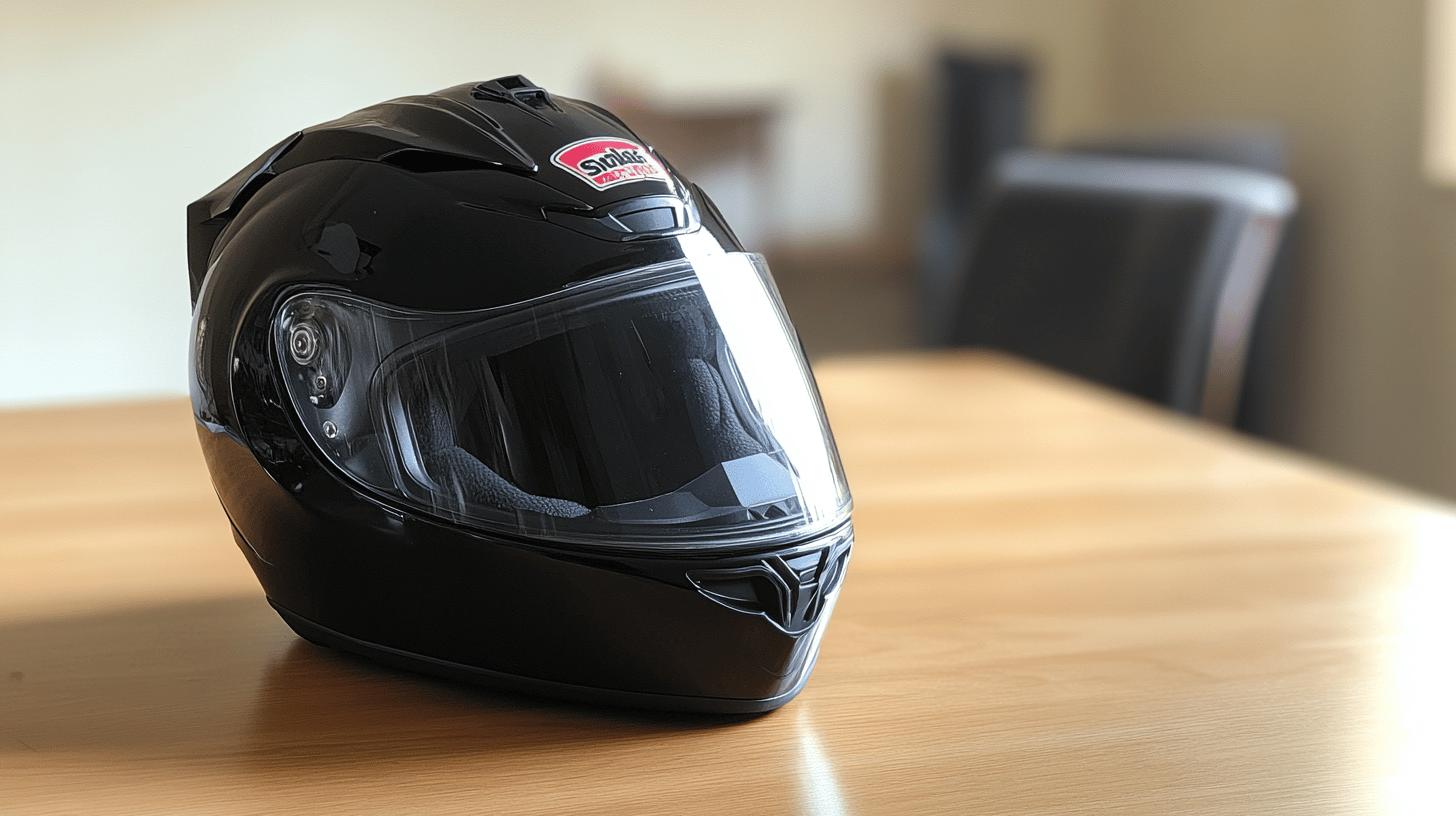Are you risking your life with inadequate helmet protection? With head injuries being a leading cause of fatalities in motorcycle crashes, choosing the right helmet is paramount. Snell-certified helmets undergo an intense gauntlet of tests, ensuring they meet the highest safety standards possible.
Established by the Snell Memorial Foundation, these helmets offer unparalleled protection through rigorous testing processes, which far exceed basic DOT standards.
In this guide, we’ll uncover which helmets have earned the Snell stamp of approval, providing the ultimate confidence in helmet safety. Get ready to explore top picks that blend protection, style, and reliability.
Understanding Snell Certification for Motorcycle Helmets

The Snell Memorial Foundation plays a crucial role in helmet safety certification, establishing standards that are recognized for their rigor. Formed in memory of Pete Snell, a race car driver who tragically died in a crash due to inadequate head protection, the foundation is dedicated to advancing helmet safety.
Its certification process is voluntary, but it's renowned for being one of the most stringent in the world. Helmets that meet Snell standards have undergone extensive testing to ensure they provide superior protection, exceeding basic safety requirements.
Snell certification involves a series of rigorous tests designed to measure a helmet's ability to withstand severe impacts. The testing criteria include a dynamic retention test, which assesses the helmet's ability to remain securely fastened during impact, and a roll-off test, which checks for the helmet's tendency to roll off the head during an accident.
Other critical tests include the chin bar impact test, which evaluates the strength and resilience of the chin bar, and the face shield penetration test, which ensures the shield can withstand high-speed impacts without shattering.
These tests collectively ensure that Snell-approved helmets offer enhanced safety features.
Compared to other certifications like DOT, Snell standards are notably more stringent. While DOT allows up to 400Gs of peak acceleration in impact tests, Snell permits only up to 275Gs, reflecting its higher safety threshold.
This distinction underscores the importance of Snell certification for riders seeking maximum protection. Helmets certified by Snell are thus seen as a benchmark for safety, providing riders assurance that they are equipped with some of the best protective technology available.
-
Dynamic retention test
-
Roll-off test
-
Chin bar impact test
- Face shield penetration test
Benefits of Choosing Snell-Approved Helmets

Snell-approved helmets offer riders a high level of assurance and reliability, with the certification serving as a benchmark in helmet safety standards. This certification signifies that a helmet has undergone rigorous and voluntary testing to meet the stringent criteria set by the Snell Memorial Foundation.
Riders can trust that these helmets provide superior protection, durability, and a commitment to safety that exceeds basic market requirements. This confidence stems from the comprehensive testing procedures that Snell helmets must pass, which are recognized throughout the industry for their thoroughness.
The rigorous testing of Snell-certified helmets translates into tangible safety benefits in real-world scenarios. The helmets are subjected to tests that evaluate their performance under extreme conditions, ensuring that they can withstand significant impacts without compromising the wearer’s safety.
These tests include assessments of impact protection, chin bar strength, and face shield penetration resistance. As a result, riders opting for Snell-approved helmets benefit from enhanced safety measures that are crucial during accidents, providing them with peace of mind while on the road.
| Benefit | Description |
|---|---|
| Enhanced impact protection | Ability to absorb and distribute force from impacts effectively. |
| Improved chin bar strength | Ensures the chin bar remains intact during collisions. |
| Superior face shield penetration resistance | Face shields can withstand high-velocity impacts without shattering. |
Popular Snell-Certified Helmet Models

Snell-certified helmets present a diverse array of options tailored to various riding styles, ensuring that every rider can find a model suited to their preferences. These helmets are recognized for combining safety, style, and functionality, appealing to riders from all walks of life.
From sleek, modern designs to vintage-inspired pieces, Snell-approved models cater to those who prioritize both aesthetic appeal and rigorous safety standards. This diversity allows riders to choose helmets that not only protect but also reflect their personal riding ethos.
Arai Contour-X and Bell Race Star Flex DLX lead the pack with their cutting-edge features. The Arai Contour-X is engineered for versatility, accommodating multiple riding styles with its aerodynamic design and advanced ventilation system.
The Bell Race Star Flex DLX, on the other hand, is tailored for sport riders, offering superior performance in forward-lean and sport tuck positions. Each helmet stands out for its unique qualities, ensuring optimal protection and comfort for its intended riding conditions.
The accessibility of Snell-certified helmets spans a broad price range, making them attainable for a wide spectrum of riders. The LS2 Street Fighter is a budget-friendly option priced under $150, offering great value without compromising safety standards.
Meanwhile, premium models like the Shoei RF-1400 provide advanced features and improved aerodynamics, justifying their higher price point. This range ensures that safety and quality are within reach for riders regardless of their budget.
Balancing style and safety, these models prove that protective gear need not sacrifice aesthetics. The Arai Classic V exemplifies this balance with its retro open-face design, while the Simpson Outlaw Bandit captures attention with its distinctive style, having gained popularity after being featured on Top Gear.
These helmets demonstrate that riders can enjoy both formidable safety features and a helmet that complements their personal style.
-
Arai Contour-X
-
Bell Race Star Flex DLX
-
LS2 Street Fighter
-
Arai Classic V
-
Simpson Outlaw Bandit
-
Shoei RF-1400
- Scorpion EXO R420
Comparing Snell with Other Helmet Certifications

Snell certification distinguishes itself through its rigorous testing criteria, which surpass those of other standards such as DOT and ECE. Snell's dynamic retention, roll-off, chin bar impact, and face shield penetration tests ensure helmets can withstand severe conditions.
Unlike DOT, which allows up to 400Gs of peak acceleration, Snell permits only 275Gs, emphasizing its commitment to safety. ECE, primarily recognized in Europe, focuses on a different set of methodologies, including shell rigidity and visor impact tests, making it comprehensive yet distinct from Snell.
The global acceptance of these certifications varies significantly. Snell certification is highly regarded in North America, with many riders seeking its assurance for their helmets. DOT, being a federal standard in the United States, is most commonly accepted across the country.
Meanwhile, ECE certification holds the widest recognition in Europe and several other regions, due to its alignment with international safety standards. Each certification reflects regional safety priorities and compliance requirements, influencing their acceptance in different markets.
These differences have practical implications for riders, especially concerning safety and legal requirements. Snell-certified helmets provide enhanced protection, making them a preferred choice for performance-oriented riders. DOT certification suffices for legal road use within the United States, but may not meet the stringent expectations of those seeking maximum safety.
In contrast, ECE-certified helmets offer a balanced approach, aligning with international regulations. Riders must understand these distinctions to choose helmets that meet both safety needs and legal mandates in their regions.
| Certification | Testing Criteria | Global Acceptance |
|---|---|---|
| Snell | Dynamic retention, roll-off, chin bar impact, face shield penetration | Highly regarded in North America |
| DOT | Allows up to 400Gs of peak acceleration | Accepted across the United States |
| ECE | Shell rigidity, visor impact tests | Widely recognized in Europe and internationally |
How to Identify Snell-Certified Helmets

When verifying if a motorcycle helmet is Snell certified, the presence of a Snell sticker is crucial. This label, typically found inside the helmet, is a clear indication that the helmet has met the rigorous safety standards set by the Snell Memorial Foundation.
The sticker not only signifies compliance with these stringent tests but also assures riders of the helmet's enhanced protective capabilities. Before purchasing, it’s imperative to inspect the helmet for this label to confirm its certification status.
For a more comprehensive verification, online resources such as the NHTSA website offer valuable assistance. Their database allows users to search for compliant helmets, providing access to detailed test results and reports.
Additionally, visiting the manufacturer's website can offer further certification details, ensuring that the helmet meets all necessary safety standards. These steps are essential for riders seeking to purchase helmets that guarantee both safety and reliability.
-
Look for the Snell sticker inside the helmet.
-
Use the NHTSA website for a comprehensive database.
-
Check the manufacturer's website for certification details.
Final Words
Exploring what motorcycle helmets are Snell approved highlights the rigorous testing process for unmatched safety. Helmets certified by the Snell Memorial Foundation offer enhanced protection through dynamic retention, roll-off, and chin bar impact tests, setting them apart from DOT standards.
Choosing a Snell-approved helmet assures reliability and protection, with models like Arai and Shoei leading the way. Understanding certification differences empowers riders to make informed decisions, ensuring both style and safety are prioritized effectively.
FAQ
What motorcycle helmets are Snell approved for sale?
A: Snell-approved helmets include models like Arai Contour-X, Bell Race Star Flex DLX, and Shoei RF-1400. These models pass stringent testing for enhanced safety and reliability.
How do you know if a helmet is Snell approved?
A: To verify Snell approval, check for a Snell sticker inside the helmet. Additionally, use the manufacturer or NHTSA websites to confirm certification details and compliance.
Are motorcycle helmets Snell rated?
A: Yes, many motorcycle helmets are Snell rated, indicating they meet stringent safety standards set by the Snell Memorial Foundation. These helmets undergo rigorous testing beyond DOT requirements.
Is Snell better than DOT?
A: Snell certification is considered more stringent than DOT, allowing up to 275Gs of peak acceleration versus DOT's 400Gs. Snell requires additional tests like face shield penetration for enhanced protection.
How do I know if my helmet is certified?
A: Look for certification stickers indicating Snell, DOT, or ECE compliance. This signifies that the helmet has met specific safety standards through rigorous testing.

Mark Anderson is a trusted expert with over 25 years of riding experience. At 56, his deep knowledge of long-distance touring and participation in major motorcycle rallies makes him a reliable source for gear recommendations on ProtectiveGearz. Mark’s decades of firsthand experience ensure his advice is authoritative and valuable to riders seeking expert guidance.



